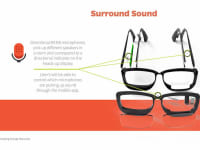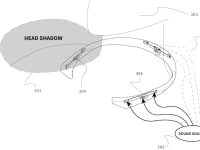In the United States, about 48 million people are deaf or hard of hearing. These numbers are expected to double in US adults alone by 2060. The current way to serve this community includes expensive hearing aids, cochlear implants, or microphones that are clipped on, worn on the speaker’s head, or passed around. These devices manipulate sound, to compensate for hearing loss.
The benefit of helping people see to hear – When we lose one of our senses, those remaining become more powerful. How can we use these ‘superpowers’ to our advantage? Through our patent pending technology, locating sound and captioning voice can help to improve communication and quality of life for the deaf and persons with ADHD.
The device and its functionalities will be housed in smart glasses to encourage better eye contact or an in-expensive ‘neck-bud’ solution. Prototypes have been developed to show sound direction on a computer and display captions on a Recon Jet and Android device.
This wearable device embedded with microphones, is worn around a person’s head or neck, locates direction of sounds and processes speech to text. Through biomimetic principles of human hearing, multiple microphones work in cohesion to determine an important sound or voice, outputting a light vibration on the skin or a visual display on a screen embedded in the device. This display of sound location gathers a person’s attention to turn toward who is speaking.
Current hearing aids and cochlear implants only compensate for sound to a limited extent. Many wearers simultaneously use visual language like sign language or lip reading, to aid communication and understanding. However, without being able to see the person speaking they miss out on parts of conversation. Thus, the display grabs their attention and gears them toward the sound by determining the important thing they need to know.
Through interviews, research, and focus groups, we identified key aspects of communication need in children and adults. For children, it was mainly in a classroom setting, and for adults, their work environment, home, and phone calls were important aspects of day-to-day communication.
Without intervention, deaf students typically fall 1 to 4 grades behind according to the American Speech-Language-Hearing Association. While ADHD students typically fall 1 to 3 grades behind. An application paired with the hardware is designed to help deaf students focus on their lessons by captioning where sound is coming from and identifying where the speaker is located. This has also proved handy for kids with ADHD, as they can review direct notes after the class while getting a little reminder to pay attention to whom is speaking.
There are endless communication applications for this technology. Producing a pair of smart glasses could cost as low as $200 in raw material costs. Costs to produce a ‘neck-bud’ device would be about $55. And, with one of these all-in-one device, care can be provided without the added costs of audiology. However, embedding the technology into hearing aids would only cost a about $15 in addition to current costs.
Video
Like this entry?
-
About the Entrant
- Name:Renee Kakareka
- Type of entry:individual
- Software used for this entry:Android, Java, Python
- Patent status:pending








